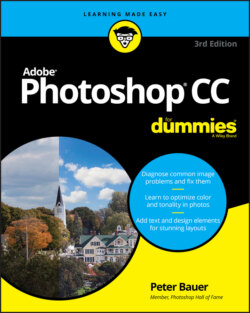Читать книгу Adobe Photoshop CC For Dummies - Peter Bauer - Страница 43
Your platter full of panels
ОглавлениеPhotoshop, like the other programs of the Adobe Creative Cloud, uses floating panels. The panels, many of which you see along the right edge of your screen, usually appear on top of (float over) your image window. (As you drag panels around to customize your workspace, as described later in this section, you’ll find that panels can hide other panels.) The Options bar across the top of the work area and the Toolbox (technically, it’s called the Tools panel) along the left edge of the screen are also panels.
Panels contain Photoshop features that you might need to access so regularly that using a menu command is inconvenient. (I can’t imagine having to mouse to a menu command every time I want to change tools or select a specific layer!) You don’t always need to have your panels visible. In Photoshop, press the Tab key to hide all the panels or press Shift+Tab to hide all but the Toolbox and the Options bar. (Press Tab again to show the panels.) With fewer panels visible, you provide more room for your image. You can selectively hide and show panels via Photoshop’s Window menu.
Photoshop uses expanding/collapsing panel docks. As shown to the right in Figure 3-3, clicking the double-arrow button at the top of a stack of panels expands or collapses that stack to a tidy group of icons. The Color, Libraries, and Layers panels are fully visible. The Swatches, Gradients, Patterns, Adjustments, Channels, and Paths panels — “nested” with the three visible panels — can be made visible by clicking the panel tab. The collapsed History, Properties, Character, and Paragraph panels together occupy only a tiny fraction of the screen — those four buttons to the left of the Color panel. In Figure 3-3, the Application Frame (Mac only) is deselected in Photoshop’s Window menu, allowing the program to utilize the entire screen.
FIGURE 3-3: Nesting and collapsing panels opens up the work area.
By clicking and dragging a panel’s tab when the panel isn’t collapsed, you can move it to another grouping or pull it out of its grouping and away from the edge of the screen. You might, for example, want to drag the Clone Source panel away from its buddies to make it more easily accessible while performing a complex clone operation. (The Clone Source panel is used with the Clone Stamp tool. You can specify up to five different source locations and easily switch among them.)
Many of the panels are resizable. Like an image window, you drag the lower-right corner of the panel to expand or contract it. Almost all the Photoshop panels have a panel menu from which you select various options. (The Toolbox and Options bar are the exceptions — they don’t have menus.) You open the panel menu by clicking the small button in the upper-right corner of the panel, as shown in Figure 3-4. The panel menu contains such options as thumbnail size (for example, the Layers, Channels, and Paths panels); how to display items in the panel (Swatches, Styles, and Brush among others); or even the size and content of the panel (Info and Histogram).
FIGURE 3-4: Access a panel’s menu by clicking the button in the upper right. (Clicking the double-arrow above the button expands or collapses the panel or panel group.)
The content of some panels changes automatically as you work with your image. Add a layer, and the Layers panel shows a new layer. Save a selection, and the Channels panel shows a new alpha channel. If you create a vector shape, the Layers panel gets a new layer, and the Paths panel shows the layer’s vector path. You control some other panels by loading and deleting content through the panel menus.
In a move that some may find controversial, the Preset Manager has been degraded and is no longer used to manage the content of most panels. Brushes, gradients, and patterns, for example, are now loaded (“imported”) and saved (“exported”) through the panel menus only. Other items, such as custom shapes, are managed through the pickers in the Options bar when the appropriate tool is active.
